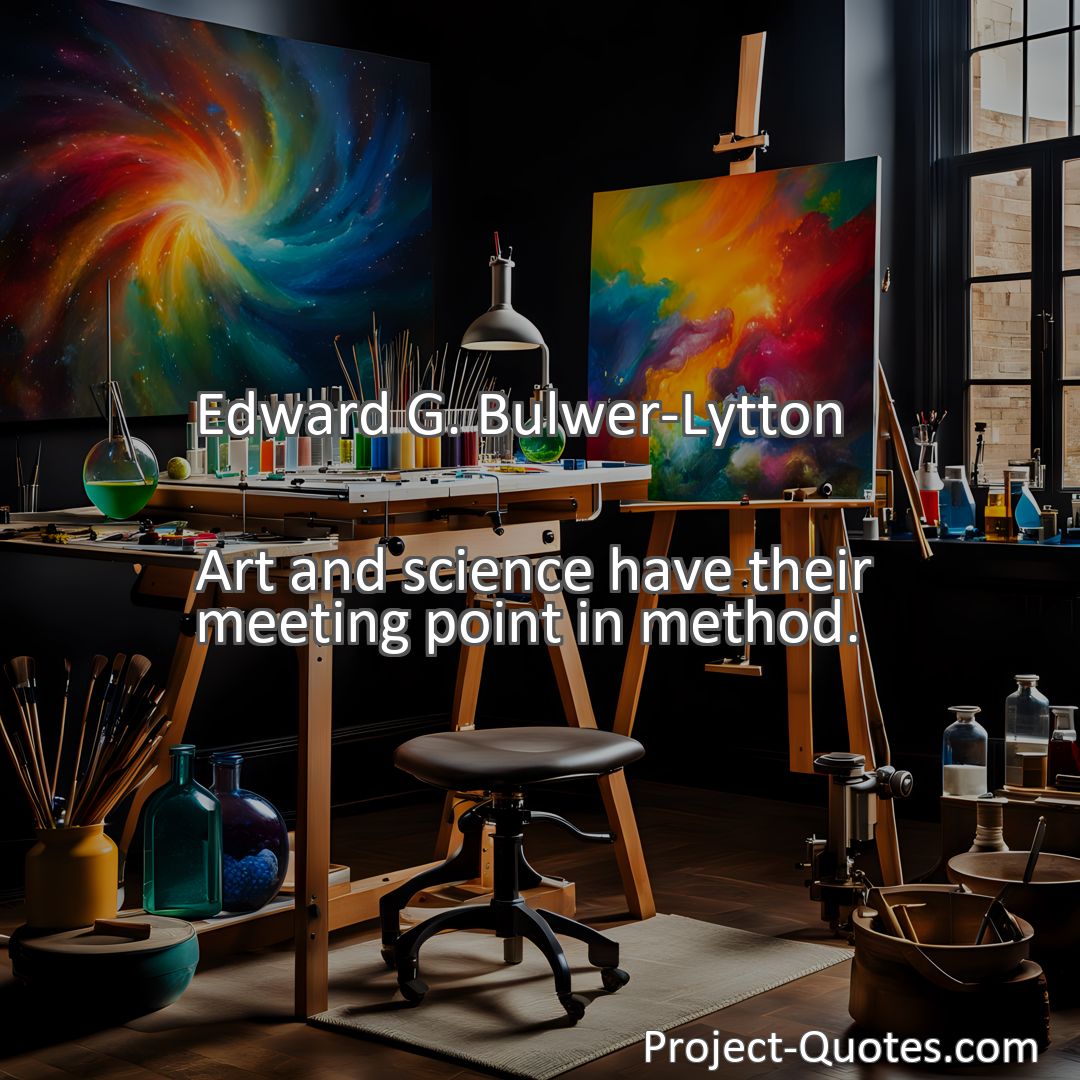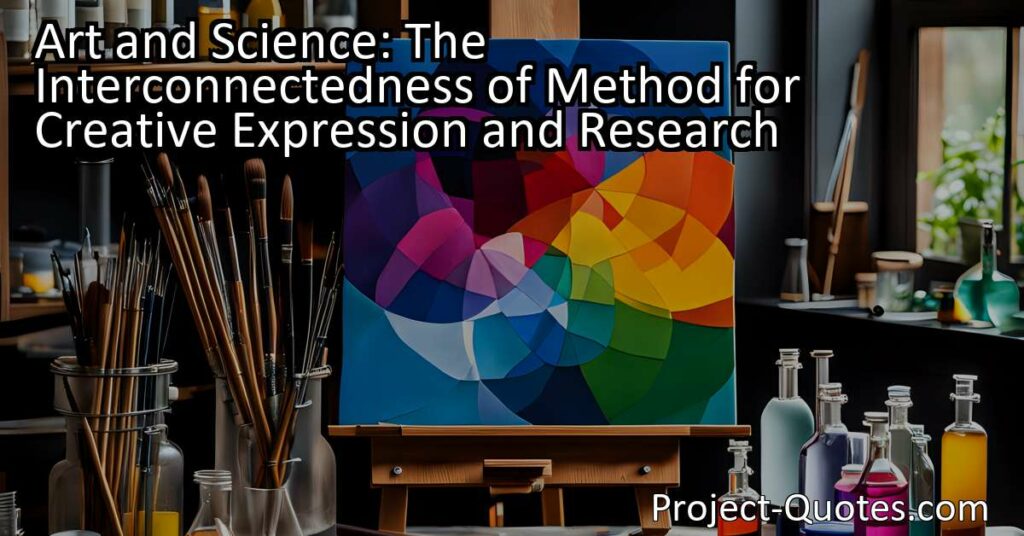Art and science have their meeting point in method.
Edward G. Bulwer-Lytton
The initial stage of the artistic process often requires research, exploration, and experimentation to refine the concept further. Artists rely on a methodical approach to achieve their desired artistic expression, which may involve planning, ideation, execution, and reflection. This parallels the systematic approach of the scientific method and highlights the interconnectedness of art and science.
Table of Contents
Meaning of Quote – Art and science have their meeting point in method.
Art and science are often seen as two separate realms, with art being associated with creativity and expression, and science being linked to logic and reason. However, Edward G. Bulwer-Lytton proposes that these seemingly distinct disciplines find their common ground in method. In other words, both art and science rely on systematic approaches and processes to achieve their respective goals. This notion sheds light on the interconnectedness of these fields and invites us to explore the essential role of method in both art and science.
To better appreciate the meeting point of art and science, it is crucial to understand the nature of each discipline. Art encompasses a wide range of creative expressions such as painting, sculpture, music, dance, and literature. It is often associated with emotions, aesthetics, and subjective interpretations. On the other hand, science is a systematic and evidence-based inquiry into the natural world. It aims to understand phenomena and establish objective knowledge through observation, experimentation, and analysis. While these definitions highlight apparent disparities, they fail to acknowledge the underlying similarities that lie within each discipline’s methodology.
Methodology refers to the systematic approach employed in the pursuit of knowledge, regardless of the field. In science, it is commonly known as the scientific method, a logical and structured process of inquiry. It involves formulating hypotheses, conducting experiments or observations, analyzing data, and drawing conclusions. This method enables scientists to test and refine theories, ensuring the reliability and validity of their findings. In contrast, art embraces various methodologies depending on the artist’s intent and medium. Artists may engage in observational drawing, experimental techniques, intuition, or even creating art through a process of improvisation. Despite these variations, artists too must adhere to a methodical approach to achieve their desired artistic expression.
Artists often follow a creative process that involves planning, ideation, execution, and reflection. They may start with a concept or an idea, which they then develop into a more tangible form through sketching or brainstorming. This initial stage often requires research, exploration, and experimentation to refine the concept further. Once the plan is established, the artist moves on to the execution phase, where they bring their vision to life using various techniques and materials. Throughout this process, artists also rely on critical analysis and reflection to assess their work and make necessary adjustments. This iterative cycle of planning, creating, and evaluating closely parallels the systematic approach of the scientific method.
By recognizing the meeting point of art and science in method, we can appreciate the intertwined relationship between these disciplines. For instance, the visual arts showcase the convergence of scientific principles such as perspective, color theory, and anatomy. By applying these scientific understandings, artists are able to create realistic and visually engaging artworks. Similarly, scientific endeavors often require a touch of creativity and artistic interpretation. Scientific illustrations and graphics, for example, employ artistic techniques to make complex concepts more accessible and visually captivating. The intricate diagrams and vibrant illustrations seen in biology textbooks or astronomy documentaries are a testament to the fusion of art and science.
Moreover, the methodology shared by art and science extends beyond the creative process to the ways in which individuals approach problems and seek solutions. Both artists and scientists rely on observation and attention to detail in their respective practices. Artists observe their surroundings keenly, capturing the nuances of light, form, and gesture. Similarly, scientists closely observe natural phenomena, collecting data and evidence to gain a deeper understanding of the world. Whether it is observing the play of light on a landscape canvas or studying the behavior of cells under a microscope, honed observational skills are vital for both artists and scientists.
Another parallel between art and science is the significance of experimentation. Just as scientists design experiments to test hypotheses, artists experiment with different materials, techniques, and styles to refine their craft. Through trial and error, artists discover new ways of achieving their desired effects, pushing the boundaries of their creativity. Similarly, scientists conduct experiments to challenge existing theories and explore new possibilities. Both art and science require an open-mindedness to experimentation, embracing failures as learning opportunities and catalysts for growth.
Method also plays a crucial role in the communication of ideas in both art and science. Artists rely on various forms of visual expression to convey their message or evoke emotions in the viewer. Whether it be a painting, a sculpture, or a dance performance, artists utilize composition, color, movement, and symbolism to communicate their intent. Similarly, scientists employ various methodologies to effectively communicate their research findings. This includes writing scientific papers, delivering presentations, and using visual aids such as charts, graphs, and diagrams. Both artists and scientists understand the significance of presenting their work in a clear and coherent manner so that their message can be easily grasped and appreciated.
In conclusion, Edward G. Bulwer-Lytton brilliantly encapsulates the interconnectedness of art and science in his quote: “Art and science have their meeting point in method.” While art and science are often perceived as distinct disciplines, their shared reliance on method underscores their common ground. Whether it is the systematic approach of the scientific method or the iterative creative process of artists, both fields embrace a structured approach to achieve their goals. Moreover, the meeting point of these disciplines is evident in the application of scientific principles in art and the infusion of creativity in scientific endeavors. By recognizing the role of method in both art and science, we gain a deeper appreciation for the interconnectedness and mutual contribution of these disciplines in our pursuit of knowledge and self-expression.
I hope this quote inspired image brings you hope and peace. Share it with someone who needs it today!


